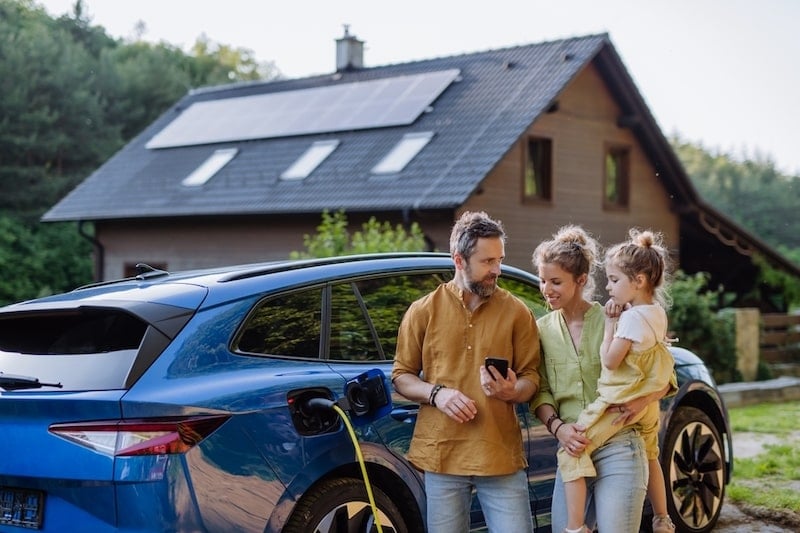
Solar EV chargers are no different from regular home chargers for your electric car, with one exception: they can optimize your charging process to use as much solar energy as possible
Solar panels installed on your property collect the energy of the sun and convert it into usable AC electricity. This electricity can either be fed directly into your household electricity network or stored in batteries for later use.
When you plug an EV into your home charger, the charger can then draw this 100% free and renewable electricity from your solar panel array via the grid or your battery storage system.
Table of contents
A sunny future for home charging
When we talk to EV drivers and those thinking about buying their first electric vehicle, we find that the things they love about e-mobility culture tend to be quite similar. EVs have a lower carbon footprint than combustion engine vehicles, helping to reduce your impact on the planet. They’re also cheaper to refuel than ICE cars and can be refueled from the comfort of your own home. These factors combine to create a cost-effective and eco-friendly reason to love EVs.
Solar panel charging, however, offers a whole new reason to become a part of the burgeoning e-mobility community.
Solar EV charging allows you to recharge your vehicle using 100% renewable, 100% free electricity, generated by the solar panels installed on your own roof. Indeed, the charge used by the average EV on most daily commutes can comfortably be replenished by the energy your PV array generates daily. This not only helps to make your EV more carbon-neutral than ever but also more affordable to run than ever before, too. Moreover, the price of solar panels continues to decrease.
The prospect of free, homegrown electricity for recharging your EV and powering your home is both exciting and encouraging, but it can also be confusing. Though the popularity of home solar systems has been steadily on the rise over the last decade, with some countries like Australia boasting a 31% residential solar adoption rate, there are still plenty of homeowners around the world who are in the dark when it comes to the power of the sun.
There are countless benefits to charging your EV with solar power, but before you go down that road you probably want to know a little more about the process.
This blog is written to help you digest all of the most important information regarding solar EV charging at home, from how solar panels generate electricity, to what they’re made of and how you can use them to recharge your electric car. By the end of the article, it is our hope that you leave feeling inspired to pursue the installation of your own EV-charging home solar panel array.
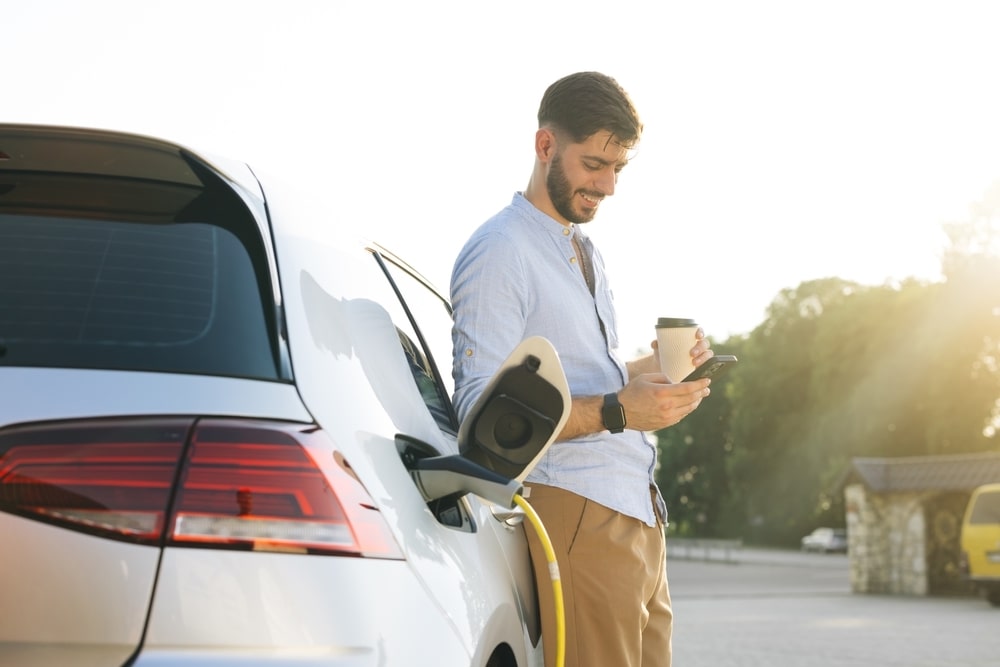
What is solar EV charging?
Where the true value of solar EV charging lies is how you can optimize the use of available solar when charging your car. In our REVOLUTION podcast episode, Jelle van Doornik, Product Manager at EVBox, delved deep into this eco-friendly and quite technical topic.
In theory, Solar EV charging involves measuring or predicting the amount of solar energy available and using precisely that amount to charge an electric vehicle. In practice, the process is a little more complicated. Solar panels produce energy variably, and, of course, there are other electrical appliances in a household that draw power. After the energy needs of the house are met, the remaining energy, often also referred to as PV (Photovoltaic) excess, solar excess, or solar surplus power, can be used for charging the EV.
“Of course, charging an EV can take a few hours, and typically your EV is plugged in for a longer amount of time than you need to charge it. So, you can shift around with the charging times depending on the availability of solar throughout the day. And that’s really how solar charging works. You try to match the time and the speed of charging to the availability of surplus solar.” –Jelle van Doornik
How charging your EV with home solar panels works
Without looking at specific features or optimization options, let’s first zoom out and look at how all home EV chargers can interact with solar power to recharge your car.

Solar EV charging stations
EV charging stations act as the conduit between the renewable energy your residential solar panels produce and the electricity your EV battery stores during a recharge.
There are numerous ways in which charging stations can interact with solar systems, but the most common means are:
- By drawing electricity from the grid as normal, the amount of it is offset by the solar electricity your panels have produced during the day and fed back to the grid.
- By drawing solar-generated electricity from the grid as provided by a utility company that deals exclusively in 100% renewable energy.
- By drawing solar-generated electricity from a household battery storage unit that has been charged by your solar panel array.
- By charging your car with optimized settings for the solar energy usage via smart charging features
- By charging your car by optimizing solar settings for multiple appliances in the house and your car via an energy management system
A look at different types and speeds of solar EV charging stations
At home, EV drivers charge their EVs using Level 1 or 2 charging (click here if you want to learn more about the different charging levels). The same explanation can be applied when solar electricity is introduced.
Level 1 solar EV charging
Level 1 solar EV charging refers to recharging your EV by plugging it directly into your home’s electrical system via a plug socket. The car will then draw power from your household electricity supply which, if you have a solar panel array installed, will be supplemented by free renewable energy (when available). Please note Level 1 charging is a lot slower than charging at Level 2, and while it’s readily accessible we don’t recommend relying on this method for your daily charging needs, read why here.
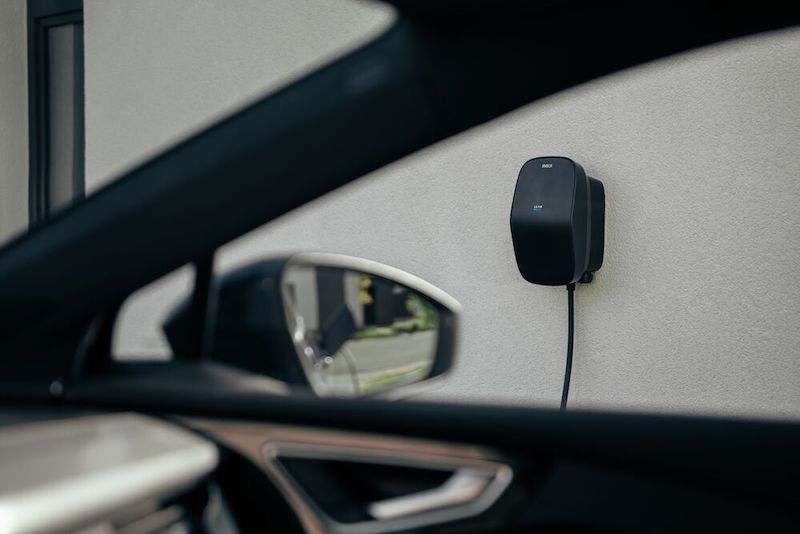
Level 2 solar EV charging
Level 2 solar EV charging refers to recharging your EV by plugging it into a dedicated home EV charging station, typically installed in your garage or by your preferred outdoor parking area. A Level 2 home charger feeds your car electricity at the ideal voltage (V) and power (kW) required by your specific vehicle and is therefore generally much faster than Level 1 charging. To avoid any confusion, Level 2 chargers interact with solar electricity in the same way Level 1 charging does. Your solar panels generate energy and if it’s available any appliance that’s connected to your electricity set-up can use it.
However, In and itself, Level 1 or Level 2 don’t necessarily offer solar optimization options and this article doesn’t focus on those specifics but is meant to give a holistic overview of how solar charging works in principle.
Understanding Solar EV charging components
Knowing now how your home EV charger uses solar energy, we’ll take a closer look at the elements that comprise a fully functional solar setup used to produce said energy.

There are three core components to any solar EV charging setup:
- Solar panels installed on the roof of the home or elsewhere on the property
- Inverters for changing solar DC electricity to readily-consumable AC electricity for the home, and charge controllers for regulating and managing the fluctuations in solar panel energy generation
- A household EV charging station for recharging your electric car’s battery using the energy generated by your solar array
Additional components in a household solar EV charging system can include non-essential yet useful elements such as:
- Battery storage units to store surplus solar electricity for use outside of sunlight hours
Solar panels
‘Solar power’ is the industry term for the power that sunlight inherently holds. ‘Solar energy’ or ‘solar electricity’ is the renewable and free electricity that solar panels can convert sunlight into. Sometimes these terms are used interchangeably, but so long as you know that solar panels convert sunlight into electricity you don’t need to worry too much about the semantics. We’ll go into more detail on exactly how solar panels do this a little later in the article.
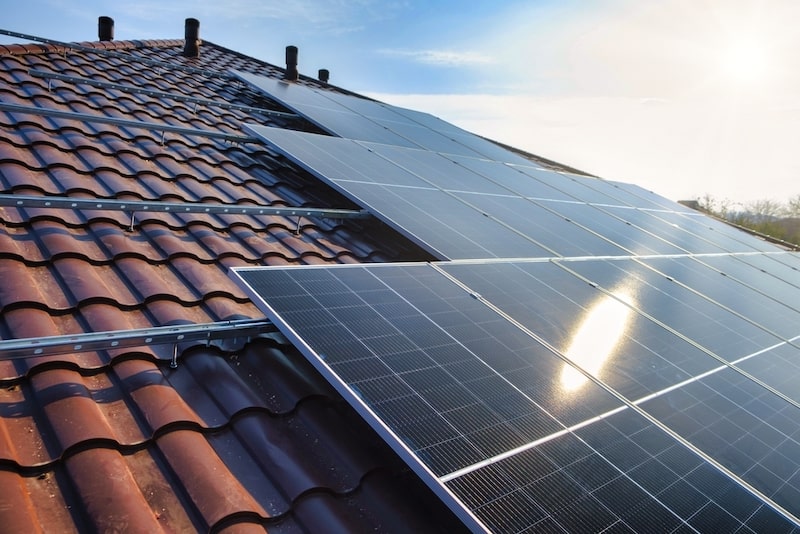
Different types of solar panels for home EV charging
There are a few different types of solar panels you can use for home EV-charging systems, and countless different brands produce these panels. The two main types of panels you’ll likely encounter when planning your solar array are:
- Polycrystalline panels: The most common and affordable type of solar panel, using Poly-Si (polycrystalline silicon) as a semiconductor. Less efficient than Mono-Si panels but kinder on the wallet.
- Monocrystalline panels: The second most common type of solar panel, uses Mono-Si (monocrystalline silicon) as a semi-conductor. More expensive than Poly-Si panels, but also more efficient and capable of producing more electricity

Chances are you may also encounter other types of solar panels. Whilst the following are less useful to home EV charging systems, it’s worth taking a moment to learn the terms.
- Thin film or flexible panels: A less common type of solar panel that is popular among those who need to install a PV array in awkward spots, such as on houseboats (the curved surfaces requiring panels flexible enough to curve).
- Bifacial solar panels: Solar panels that are semi-transparent, allowing light to diffuse through, reflect, and be reabsorbed from the opposite direction, as well as from in the direction of the sun.
- Solar shingles, solar tiles, or solar roofs: A fairly new type of solar panel technology that allows entire roofs to be made of PV panels. For example, Tesla has developed its own ‘solar roof’ with a 25-year warranty. These types of panel arrays are liable to be the most expensive, however, they are promising – especially for a future driven by EVs.
Inverters
Solar panels produce electricity in direct current (DC) which, though the same current EV batteries use, is incompatible with household electrics and the grid. As such, the electricity generated by solar panels must first be ‘inverted’ from DC to usable AC before it can be fed into the home or your home EV charging station.
Solar-generated DC needs to be converted to AC
Direct current (DC) can be thought of as a straight horizontal line of electricity that flows only one way. Alternating current (AC), on the other hand, flows both ways and so is thought of as a steady wave, called a ‘sine wave’.
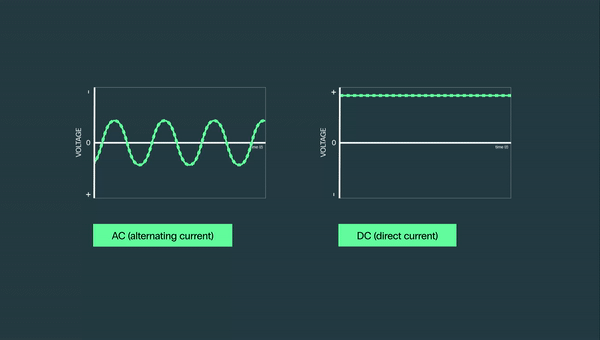
To be as efficient and effective as possible, solar panel inverters must convert the DC generated into as ‘pure’ a sine wave as possible.
The cheapest inverters do so via mechanical switches, whilst more advanced, so-called ‘modified sine wave inverters,’ use relatively simple technology to manipulate a direct current into an approximation of a sine wave.
However, the best inverters are those that can produce a ‘pure sine wave,’ called ‘pure sine wave inverters.’ These inverters use the latest technology to match the DC produced by your solar panel array to the AC electricity circulating in your local or national electricity grid. In doing so, they produce the most efficient version of solar electricity with minimal energy loss in conversion – ideal for recharging your electric car battery.
Understanding the difference between ‘string inverters’ and ‘microinverters’
Solar panel inverters, regardless of their type, may belong to one of two categories: string or micro. Understanding the difference between these may help you maximize the eventual efficiency of your EV-charging solar system.
String Inverters
String inverters are the most common and economical solar panel inverters, and are installed once per solar array (up to a max. number of panels). They connect the charge produced by the whole array and invert it before sending it to your EV charger.
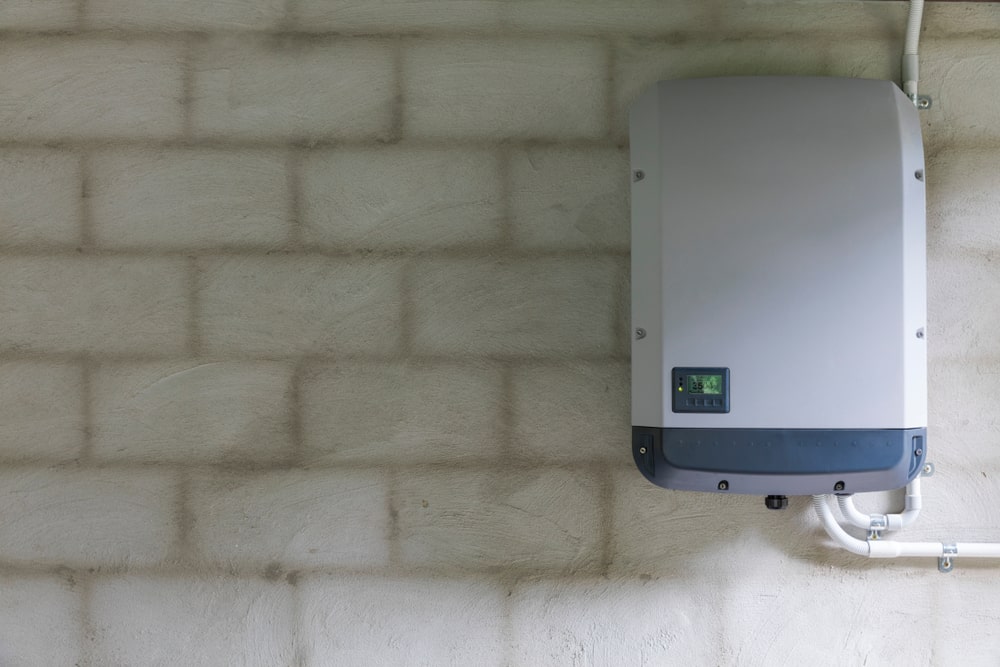
Microinverters
Microinverters are cutting-edge solar technology, more expensive yet also more efficient than string inverters. Microinverters are installed at the PV module level, meaning each panel has one, thus increasing the efficiency of energy generation and limiting the loss of energy through inversion. In other words, the DC produced by each panel is immediately inverted to AC before being fed through the rest of the household solar EV-charging system.
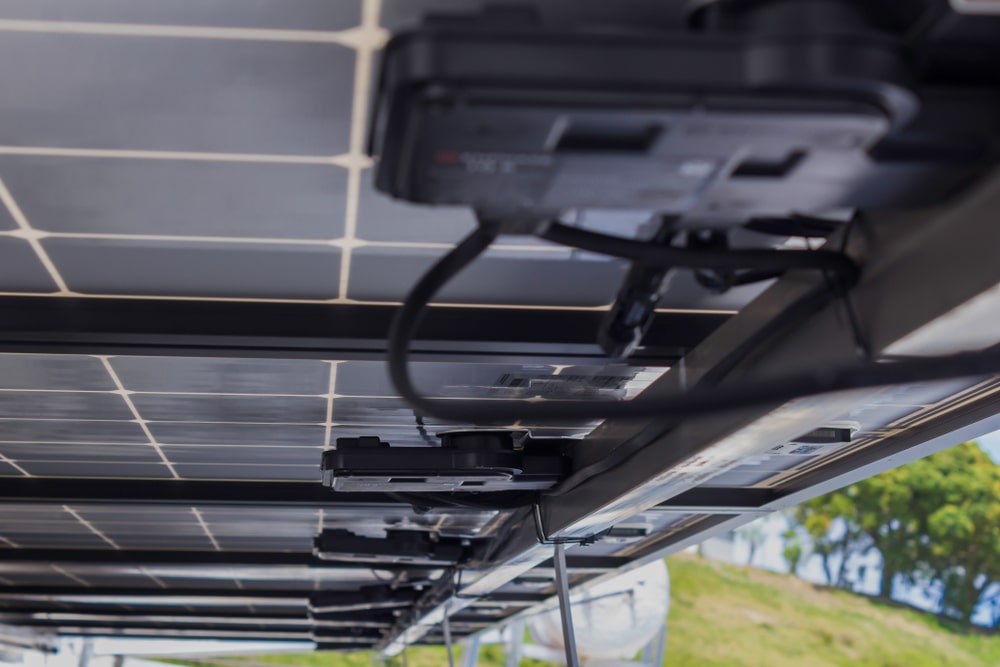
Solar charge controllers
Solar panels are hit by different amounts and strengths of sunlight at different times of the day and throughout different times of the year. As such, the amount of electricity produced by your panels will fluctuate throughout the day, month, and year. To ensure your panels are operating at maximum efficiency without overloading your EV-charging system, a solar charge controller is required.
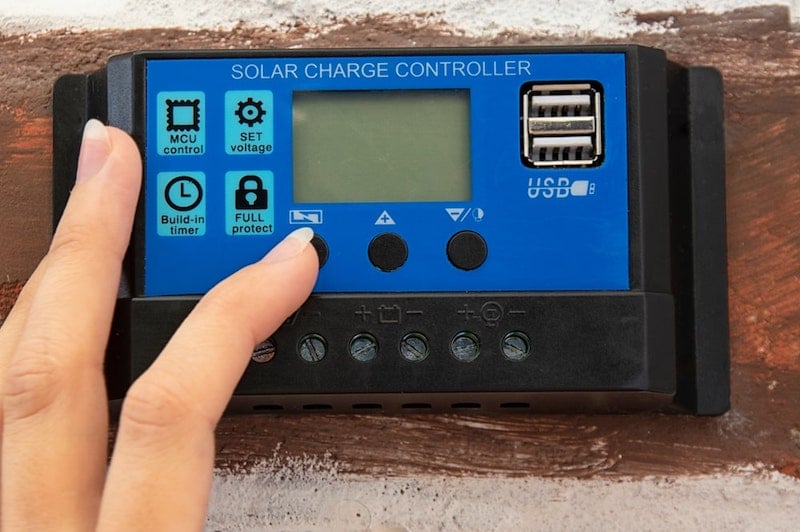
Charge controllers are designed to regulate the production of electricity by your solar panels. These nifty gadgets can do so in a few different ways, but most commonly charge controllers act as a valve, ensuring the electricity produced by your panels only flows one way: from the panels to the home.
MPPT (maximum power point tracking) controllers are even more effective as they offer a bonus. These charge controllers allow you to harvest solar electricity at the optimal voltage for your panels, before dropping the voltage to match your household EV charging system. In the simplest terms, this is like a baker baking the biggest cake their oven can hold, but ensuring that you are only served the size of portion you ordered, instead of the whole thing.
The solar charging process
We’ve discussed how home EV chargers use solar electricity to recharge your car’s battery, as well as the various key components that comprise an efficient and effective solar EV charging system. Finally, we’ll give you the lowdown on how solar panels work, and how you can best use their electricity to charge your vehicle.
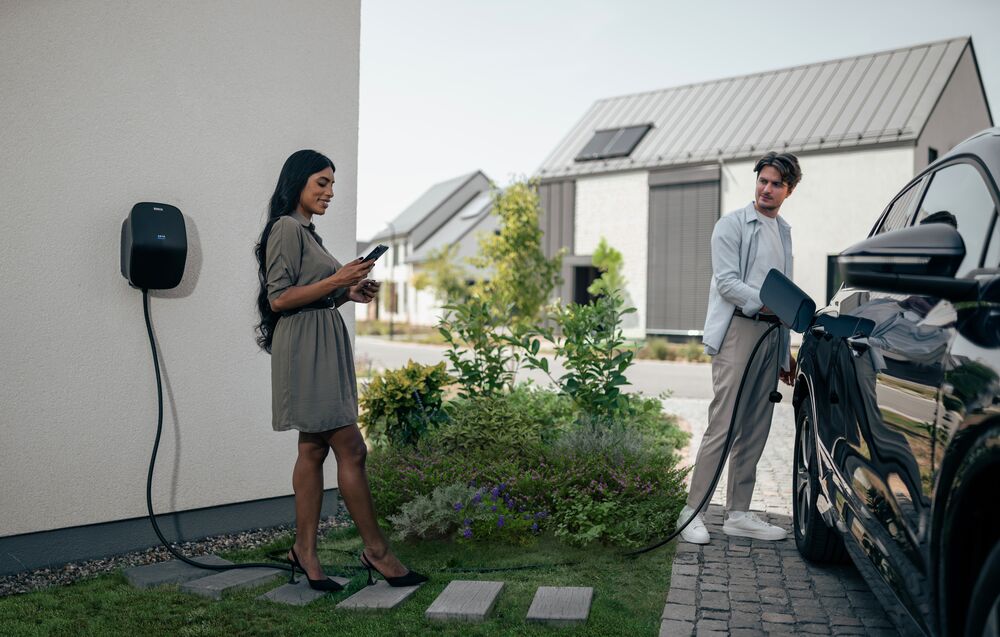
Solar energy collection
The process by which solar panels convert sunlight to usable electricity is known as the ‘photovoltaic process;’ as such you may occasionally see solar panels referred to as ‘PV (photovoltaic) panels’.
During the photovoltaic process, sunlight hits the many solar cells which make up an individual panel. These cells contain a semiconductor, commonly silicon, which reacts to the sunlight, releasing electrons and forcing them to move across the solar cell.
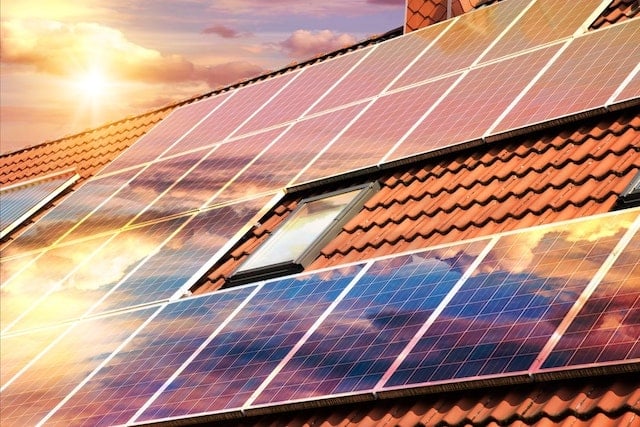
This displacement of electrons occurs many times over, generating electricity as a result, which is then collected by the electrical wiring in the solar panel. As previously discussed, this electricity is produced as a direct current before being inverted to alternating current and sent to your EV charger.
Storing solar energy for EV charging
Solar panels can only generate electricity when exposed to sunlight during daylight hours, which makes it difficult to use this energy to recharge your EV overnight. Difficult, but not impossible. To use solar electricity outside of daylight hours, you can install a battery storage unit at home, in which to store the renewable electricity until you need to use it.
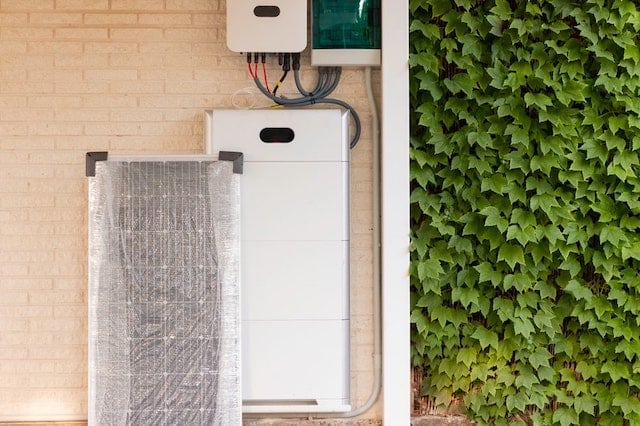
Charging EVs with solar electricity: Does every EV charger work with solar?
Technically, all home EV chargers can use solar power to charge your car. The solar inverters attached to your panels convert electricity into AC for your charger to use, which is then re-converted back to DC by your car battery. As such, any home AC charger you have installed can draw electricity from your solar panels without a problem.

Conclusion
There are various combinations of technologies you can use when installing your own residential solar EV-charging system, whether you intend to tie your solar-generated electricity into the grid, operate off-grid, or use it solely to recharge your EV.
The basics of the system operate the same regardless. Sunlight hits reactive materials in your solar panels, which stimulates the generation of DC electricity. This direct current energy is regulated by a charge controller and an inverter, which – ideally – changes the DC electricity into pure sine wave AC. Your panels have now produced 100% renewable and free electricity for your household appliances, including your EV, to use.
Solar electricity is passed from your rooftop array into either the home’s electrical network, a solar generator, or a battery storage unit. From there, the electricity can be used to recharge your EV batteries via Level 1 or Level 2 charging – the latter requiring a quality home AC charger.
Though undoubtedly complex, the long and short of it is that residential solar panels offer a unique opportunity to further reduce your carbon footprint, your utility bills, and your EV recharging bill. To find out more, or take the next step on your journey toward home solar EV charging, explore the EVBox blog.
Related articles

Smart Charging for Solar EV Systems: What is possible today?
There are a variety of smart solutions available, capable of optimizing your solar EV charging system in different...

Can solar EV charging save you money?
Charging your EV using household solar panels can indeed save you money on your utility bills. How much money solar EV...
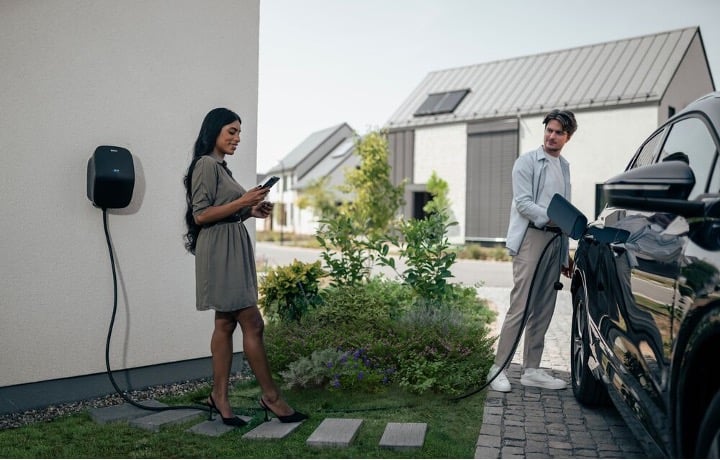
How to optimize your solar set-up for charging electric cars at home
There are several ways EV drivers can optimize a homegrown solar system to ensure their EV recharging needs are met....
